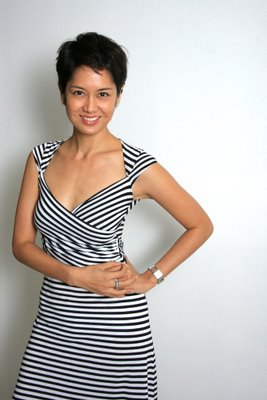In praise of flash
Funny how the first thing people who like taking pictures figure out is “I don’t like flash”. I can’t blame them, direct flash, at night, is often very, very ugly. But I do have to make a case for bounce flash and fill flash. First off, sometimes there just isn’t much light and if you still want to take a picture home, well you’re going to have to make light. More light also means a lower ISO and less noise. So instead of just skipping those pictures, or taking them with loads of motion blur and noise, get yourself the kind of flash that has a head that rotates in every direction and try to bounce it off a wall or ceiling. Have a look at this:

Thames and his buddy whose name I forgot, of defunct Thai boy's band 3+1
This was shoot with a Panasonic DMC-FZ30 in the Sony BMG building in Bangkok. That’s a crap camera, and Sony’s offices are, well, offices. This is actually the kitchen. The windows are stained very dark (this is Bangkok), and even if they provide some diffuse indirect light coming from the right of the frame, it was quite weak. Let me add that that Panasonic is a very noisy camera which really can’t deal with high-ISO. Not only the locale and camera were shit but so is my flash, a Vivitar 3200A (guide number 28 at ISO 100). I cost me about two or three thousand baht (40-60 euros) two years ago when I got it to shoot peel-apart Polaroids of Muay Thai boxers with a 600SE—but that’s another story. The flash is supposed to be automatic (there’s a light cell on the front that tells the flash how much light is bouncing back) but that never really worked in real life. I just put it in manual, so that it fires all it can, and then play with the camera settings.
The shoot looks quite pro and studio-like, I’d say. I had like 5 minutes to shoot it as these guys were doing lots of interviews that day. It’s far from perfect but it certainly doesn’t have that violent “in your face” look people equate with flashes.

former Miss Thailand representative at the Miss Universe competition
A week later, I had my Canon 350d and tried the same thing. By squeezing between a white column and a white wall, I had both a white background and a white surface to bounce the flash off of which was not above but behind me—a very nice setup indeed! The convex shape of the column was very hard on the flash which turned out to be underpowered for the job (convex shapes diffuse light too much) but again, you must realize this shot was taken in a shopping mall and in 5 minutes time! Does it look that way?
I had a hard time getting the right exposure on these, and screwed most of them up, but it doesn’t have to be that way. You can get a nice flash of your camera’s brand that will fully communicate with your camera to get perfect exposure, whatever the light is bouncing off of. You can even control other flashes with high-end flashes and make set-ups, in the field, of several lights. Again, everything is automated and adjustable. Nikon’s high-end flash is the SB800; Canon’s is the 580EX. These cost the price of a decent single focal lens but I think they’re worth it if you want to get creative with light. Remember that even outdoors and in sunlight, fill-flash can greatly improve your pictures.
I haven't really had time to experiment with fill-flash yet (direct flash, usually outside and in sunlight). You can see examples on Dave Black's site. He does amazing stuff with his Nikon SB800's.

Thames and his buddy whose name I forgot, of defunct Thai boy's band 3+1
This was shoot with a Panasonic DMC-FZ30 in the Sony BMG building in Bangkok. That’s a crap camera, and Sony’s offices are, well, offices. This is actually the kitchen. The windows are stained very dark (this is Bangkok), and even if they provide some diffuse indirect light coming from the right of the frame, it was quite weak. Let me add that that Panasonic is a very noisy camera which really can’t deal with high-ISO. Not only the locale and camera were shit but so is my flash, a Vivitar 3200A (guide number 28 at ISO 100). I cost me about two or three thousand baht (40-60 euros) two years ago when I got it to shoot peel-apart Polaroids of Muay Thai boxers with a 600SE—but that’s another story. The flash is supposed to be automatic (there’s a light cell on the front that tells the flash how much light is bouncing back) but that never really worked in real life. I just put it in manual, so that it fires all it can, and then play with the camera settings.
The shoot looks quite pro and studio-like, I’d say. I had like 5 minutes to shoot it as these guys were doing lots of interviews that day. It’s far from perfect but it certainly doesn’t have that violent “in your face” look people equate with flashes.

former Miss Thailand representative at the Miss Universe competition
A week later, I had my Canon 350d and tried the same thing. By squeezing between a white column and a white wall, I had both a white background and a white surface to bounce the flash off of which was not above but behind me—a very nice setup indeed! The convex shape of the column was very hard on the flash which turned out to be underpowered for the job (convex shapes diffuse light too much) but again, you must realize this shot was taken in a shopping mall and in 5 minutes time! Does it look that way?
I had a hard time getting the right exposure on these, and screwed most of them up, but it doesn’t have to be that way. You can get a nice flash of your camera’s brand that will fully communicate with your camera to get perfect exposure, whatever the light is bouncing off of. You can even control other flashes with high-end flashes and make set-ups, in the field, of several lights. Again, everything is automated and adjustable. Nikon’s high-end flash is the SB800; Canon’s is the 580EX. These cost the price of a decent single focal lens but I think they’re worth it if you want to get creative with light. Remember that even outdoors and in sunlight, fill-flash can greatly improve your pictures.
I haven't really had time to experiment with fill-flash yet (direct flash, usually outside and in sunlight). You can see examples on Dave Black's site. He does amazing stuff with his Nikon SB800's.













